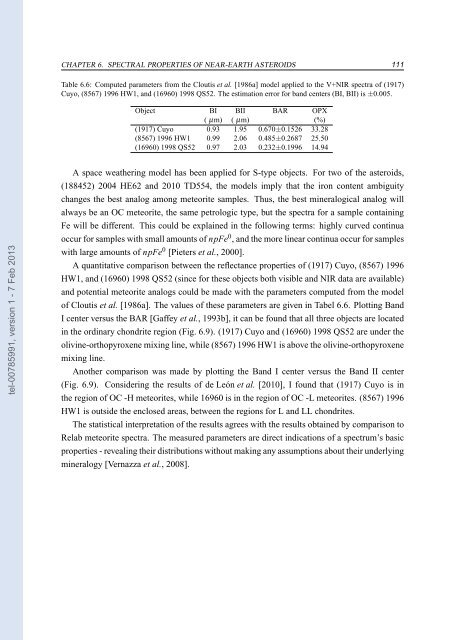Techniques d'observation spectroscopique d'astéroïdes
Techniques d'observation spectroscopique d'astéroïdes
Techniques d'observation spectroscopique d'astéroïdes
Create successful ePaper yourself
Turn your PDF publications into a flip-book with our unique Google optimized e-Paper software.
CHAPTER 6. SPECTRAL PROPERTIES OF NEAR-EARTH ASTEROIDS 111<br />
Table 6.6: Computed parameters from the Cloutis et al. [1986a] model applied to the V+NIR spectra of (1917)<br />
Cuyo, (8567) 1996 HW1, and (16960) 1998 QS52. The estimation error for band centers (BI, BII) is±0.005.<br />
Object BI BII BAR OPX<br />
( µm) ( µm) (%)<br />
(1917) Cuyo 0.93 1.95 0.670±0.1526 33.28<br />
(8567) 1996 HW1 0.99 2.06 0.485±0.2687 25.50<br />
(16960) 1998 QS52 0.97 2.03 0.232±0.1996 14.94<br />
tel-00785991, version 1 - 7 Feb 2013<br />
A space weathering model has been applied for S-type objects. For two of the asteroids,<br />
(188452) 2004 HE62 and 2010 TD554, the models imply that the iron content ambiguity<br />
changes the best analog among meteorite samples. Thus, the best mineralogical analog will<br />
always be an OC meteorite, the same petrologic type, but the spectra for a sample containing<br />
Fe will be different. This could be explained in the following terms: highly curved continua<br />
occur for samples with small amounts of npFe 0 , and the more linear continua occur for samples<br />
with large amounts of npFe 0 [Pieters et al., 2000].<br />
A quantitative comparison between the reflectance properties of (1917) Cuyo, (8567) 1996<br />
HW1, and (16960) 1998 QS52 (since for these objects both visible and NIR data are available)<br />
and potential meteorite analogs could be made with the parameters computed from the model<br />
of Cloutis et al. [1986a]. The values of these parameters are given in Tabel 6.6. Plotting Band<br />
I center versus the BAR [Gaffey et al., 1993b], it can be found that all three objects are located<br />
in the ordinary chondrite region (Fig. 6.9). (1917) Cuyo and (16960) 1998 QS52 are under the<br />
olivine-orthopyroxene mixing line, while (8567) 1996 HW1 is above the olivine-orthopyroxene<br />
mixing line.<br />
Another comparison was made by plotting the Band I center versus the Band II center<br />
(Fig. 6.9). Considering the results of de León et al. [2010], I found that (1917) Cuyo is in<br />
the region of OC -H meteorites, while 16960 is in the region of OC -L meteorites. (8567) 1996<br />
HW1 is outside the enclosed areas, between the regions for L and LL chondrites.<br />
The statistical interpretation of the results agrees with the results obtained by comparison to<br />
Relab meteorite spectra. The measured parameters are direct indications of a spectrum’s basic<br />
properties - revealing their distributions without making any assumptions about their underlying<br />
mineralogy [Vernazza et al., 2008].
















